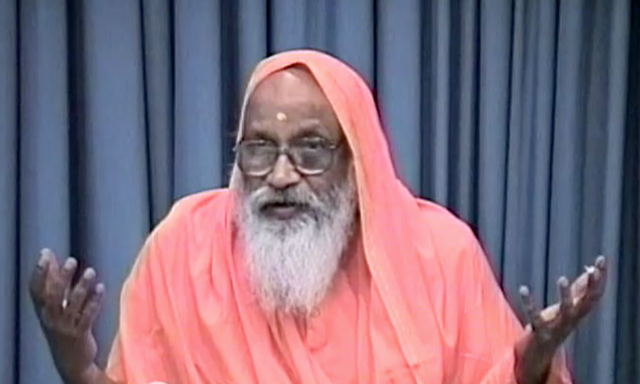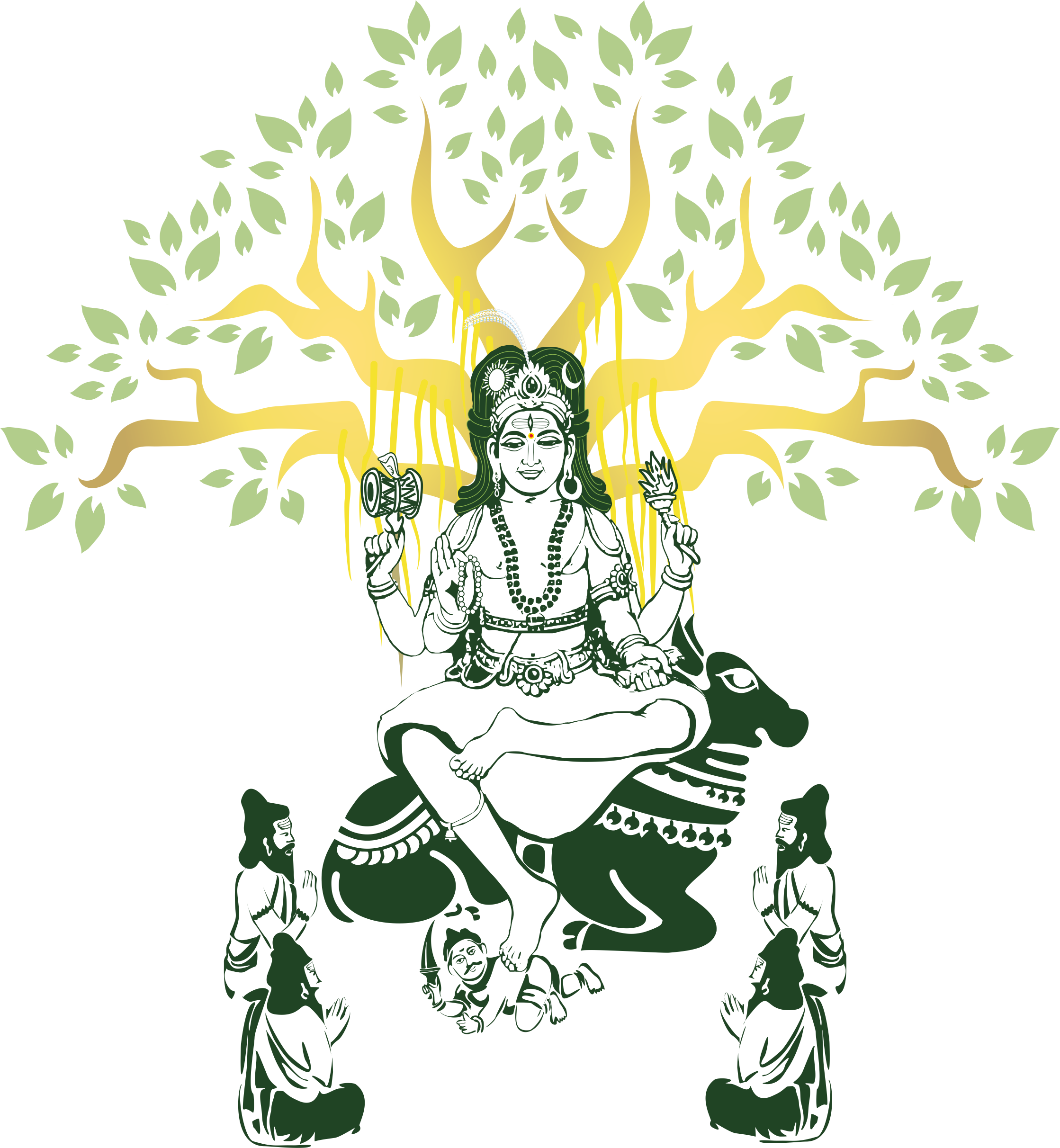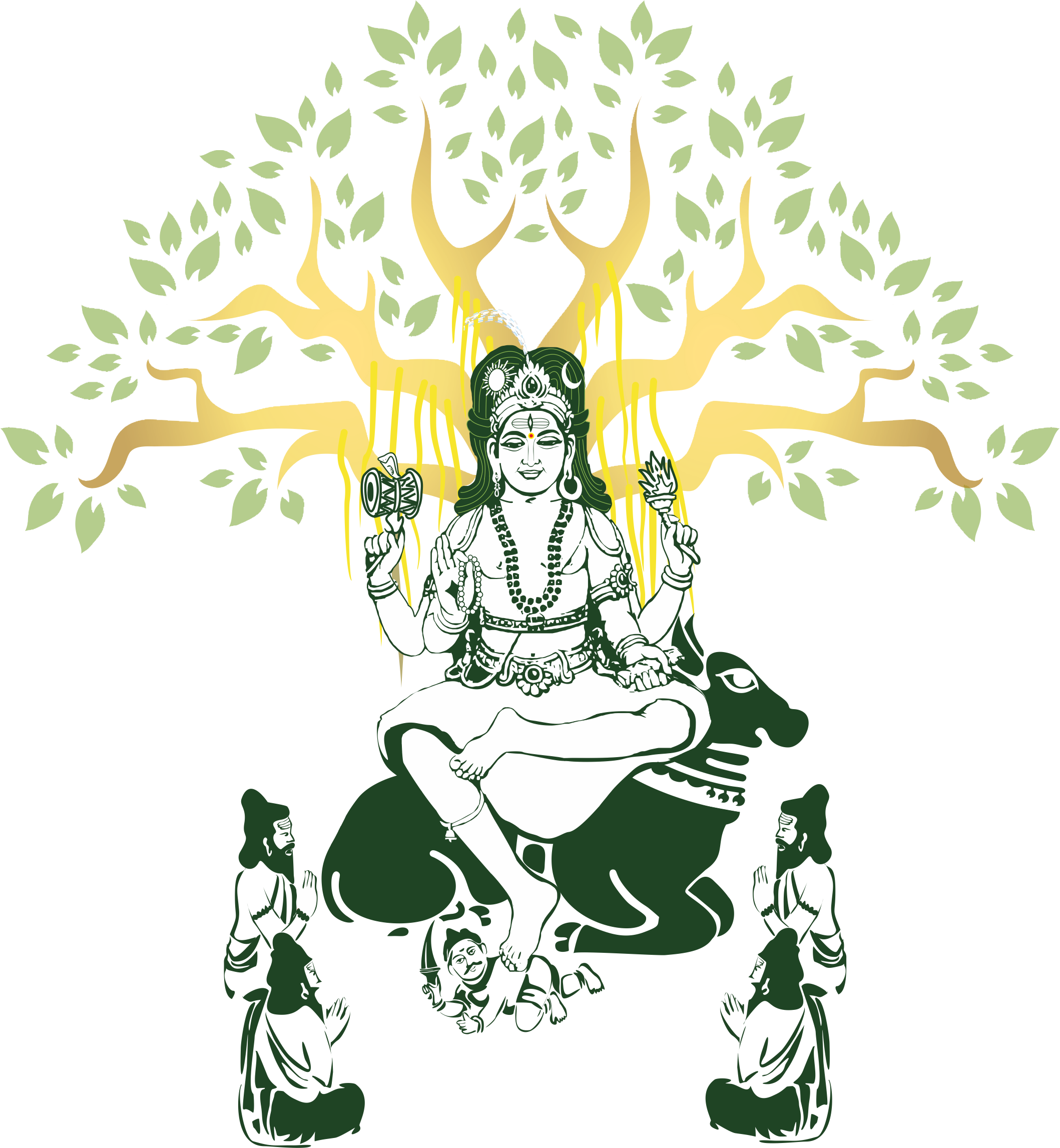Satsanga with Pujya Swami Dayananda Saraswati

Excerpted from satsaṅga with Pūjya Swami Dayananda Saraswati held in Oct 2014 at the Dayananda Ashram, Rishikesh for a group of CEOs. This is Part I of the Satsanga. The audio recordings were transcribed by Ramanujam Raman, Harish Biladi, Shridhar Rajarao, Sudhakar Apadharana, and Surekha Bhatt, and edited by V. Swaminathan, respectively.
Question: The inner leisure you speak of in the morning meditations is amazing. The connection with īśvara is very real and the inner leisure is there for some time, because of the total acceptance that you taught us in meditation. But the problem is to sustain that inner leisure during the course of the day when things that happen which are not very palatable, and when you interact with people with whom you cannot see eye to eye.
How to maintain leisure in different relationships and work environments?
Pujya Swamiji: When you do pūjā and meditation, you have connectedness with īśvara, and enjoy the inner leisure. That is a blessing. When you say that someone does not see eye to eye with you, you have to learn to accept that in his/her eyes, you are the one who does not see eye to eye. It is not one-sided. Therefore, we have to accept that ‘I don’t see eye to eye.’ The other person also has the right not to see eye to eye with you. Everybody has got the right to have his/her own perception. We cannot own others’ perceptions. You allow them to have their own perceptions. The acceptance that others’ perceptions can differ from yours gives you a degree of leisure. We have to interact with people. Life is like that. In fact, we are born as an individual relating to the total. We have many circles of relationships. Even unknown people are related to you, their actions can bother you, their actions can disturb you. You read in the newspaper that ‘somebody did this or that.’ That somebody is not known to you, yet it affects you. We are born with the vyaṣṭi (individual), and samaṣṭi (total) difference. The total exists at different levels. Therefore, you can get affected by the total because the total is more powerful than the individual, the individual ‘you’. It can affect you. You have to learn to keep outside the people and things that affect you so that your leisure is not affected. Thank God, they are already outside.
Question: Isn’t drawing boundaries especially difficult?
Pujya Swamiji: You have to draw boundaries for yourself as well as for others. The boundary, the Ḷakṣmaṇarēkhā, which permits only that far and no further. You draw boundaries so that others don’t tread upon you, and likewise, you don’t tread upon others. Drawing boundaries helps you retain your inner leisure which is your connected-ness with īśvara.
Question: You spoke about certain happiness that comes from being associated with īśvara. In this journey towards the knowledge of the self, one begins to have lesser and lesser value for the external material objects, like a car or whatever, which were looked upon as objects of happiness previously. Could you please expand on this dimension of happiness when one is on the journey towards knowledge of the self?
Pujya Swamiji: In the beginning, there will be certain distaste, withdrawal from certain objects, and certain values that you had before. But they all will come back when you discover a certain leisure. You can look upon your wealth as a means to help others. You can do those things through which many people are benefitted. This is seva, helping others. Therefore, this decrease in interest in usual pursuits is only temporary. You can direct them for seva. I am a sadhu, but I have the All India Movement for Seva which has built more than 100 plus chatralayas all over the country benefitting thousands of people. I ask all the sadhus to do seva. You don’t lose anything but others gain. In seva, there is joy. If you have the riches with you, you are just rich. When you do seva, you become richer because your heart has expanded to accommodate more people.
Question: What is the difference between attachment, and love, especially in the context of one’s children and family? Sometimes attachment becomes Overbearing.
Pujya Swamiji: Love is free from boundaries. You love your children; you love other children. Love knows no boundaries whereas attachment is confined. The Gītā says, “asaktiranabhiṣvaṅgaḥputradāragṛhādiṣu2 .”abhiṣvaṅgaḥ is atisnehaḥ; sneha is affection and atisneha is attachment.
One must have anabhiṣvaṅgaḥ, naatisnehaḥ with reference to children, wife, home, vehicle, job, wealth etc. You must have affection. You must differentiate attachment from affection. Attachment is doting on somebody. It is not good for the children also. Children grow well if we give them space to grow up. Space is not only outer space but inner space. Pray for them, teach them, and allow them to grow. They will grow very well. Affection, sneha, is required. It is mandatory. You have to show your affection overtly. Indian parents don’t have the habit of showing overtly their affection for their children. This was so because of the joint family. One will not show overt affection on one’s own children because the brother’s children will also be there. They will exhibit affection for the brother’s children but not to their own. Now also this habit continues even though the joint family is no longer there. Overt affection is necessary. Overt means external. It is very important. The children need that. I am appealing to parents to show overt affection towards children. One should also be overtly affectionate with one’s spouse.
Question: How do I explain the presence of God to children? Our son is 21 years old. We brought him up with good values, and he is a very good person. He is not an atheist but he questions the presence of God. He wants a scientific explanation for everything. So, how do we handle this?
Pujya Swamiji: All that is here is God. Where is the question of the presence of God? We don’t need to give an address for Bhagavān. All that is here is God. Then he has no question. His question is how? You ask him how he acquired his body. Where is the knowledge? Without prior knowledge, you cannot create even kitchidi which is the easiest thing to make. Even I can do it. Nevertheless, making kitchidi requires knowledge. This body cannot be created without knowledge. By whom is it created? Who has the knowledge to create not just one body but the whole jagat. You need to explain this to him. Bring him to the retreats in Arsha Vidya Gurukulam to get exposure to the teaching.
Question: It is said in the corporate world that to succeed one must have a killer instinct. This creates a lot of disturbance for oneself and others. Would Swamiji comment on this?
Pujya Swamiji: I once read a leaflet which said, ‘An executive is paid to execute.’ He can’t give excuses. He has to deliver constantly. But this is not possible. Even the best batsman in cricket can get out. He can have a killer instinct alright but then he can lose the middle stump. We cannot be blind to the law of probability. Even a rock thrown up will come down at the acceleration of 32 ft/sec/sec. We don’t have the last word in everything. This is the reality. Therefore, it is better to have a humble attitude. The ensuing inner leisure will allow one to do the job better, and to make proper decisions. “I don’t think that there is anything that I cannot do,” is the meaning of killer instinct. I would rather prefer to have the attitude of “Why not? I will succeed!” I open my mouth and talk. This is success. I walk, and reach the other side of the road, it is success. I eat, and then again, I am hungry, another success. My whole life is a story of success after success, after success, after success. The killer instinct which is a heart-breaking pressure for the executives can be abandoned. Instead, “Why not? I will succeed!” is a better attitude to have.
Question: Having the killer instinct may also lead to achieving the goals by the wrong means. Could you shed light on the means to achieve the desired goals?
Pujya Swamiji: Quite often one faces the conflict of dharma and adharma while endeavoring to achieve one’s goals. In life, one has to achieve the goal of dharma also. Nowhere in the world dharma is considered as an end to be accomplished. In the Vedic culture, human ends, puruṣārtha, are four-fold – dharma, artha, kāma, and mōkṣa. Dharma is to be accomplished first. Artha is the pursuit of wealth, power, name, and security. Kāma is various avenues of pleasure. Dharma does not sub-serve artha and kāma. Since dharma can be in conflict with the pursuit of artha and kāma, it is considered as an end to be accomplished by a human being. Dharma is kula-dharma, ācārya-dharma, śiṣya-dharma, bhakta’s dharma, husband’s dharma, wife’s dharma, son’s dharma, doctor’s dharma – there is dharma for every role. Therefore, no achievement is worth it at the cost of dharma. This is indeed a big recognition.
Question: The reality is that the competition may not be playing by dharma. How do you resolve this dichotomy?
Pujya Swamiji: It is true that according to the dēśa-kāla, place, and time, the norms of dharma get challenged. In the Mahābhārata war, the two sides did not go by dharma all the time. There were compromises made. However, adharma is still adharma and one has to do prāyaścitta, atonement. This can be in the form of a pūrta3 karma, that is, doing something for the benefit of the community.
Question: How does chanting the Viṣṇusahasranāmam or the ṢrīRudram help one?
Pujya Swamiji: The chanting helps but then if you know the meaning, it will help better. We have books on these two4. Please read the books. Read the books, twice, thrice, four times so that you remember the meanings.
Question: When we want to achieve something some of us raise the bar by ourselves. Sometimes this raising the bar disturbs our inner peace. We are constantly pushing ourselves with the thought, “I got to get there.” How do we know when to stop raising the bar, and how to stop it?
Pujya Swamiji: When you walk on a dark road, you have a torch in your hand. This torch will light up only about 10 feet. So you go 10 feet. You have to walk 10 miles but now you walk only 10 feet because only that much light you have. Similarly, your goal is to be reduced to many pieces. What is that you have to achieve in a given day, that alone you work towards accomplishing that day. This way, you can achieve a lot of good things. Even planning for the future is today’s planning. Tomorrow you can either conform with it or change it. Really, by living one day at a time, you will retain the inner leisure.
Question: Can you please expand further how to understand that all that is here is Īśvara?
Pujya Swamiji: I said that everything is given. The world is given; sun is given; the laws are given; my body also is given through parents. The parents don’t have the knowledge of how the body is made, how the eyes are made, how the ears are made etc. They do not have the knowledge. But then, without knowledge there cannot be an intelligently put together creation, such as the human body. In fact, everything in the universe is intelligently put together. It is an intelligent creation. Therefore, knowledge must be somewhere. There is no other individual who can have all the knowledge to create the universe. I say all knowledge. All ears hear; all eyes see; all human minds emote, think, know, get confused, and get clarity. It is all given.
The giver is called Īśvara, and the given is not separate from the giver. In this country you cannot ask the question, ‘where is Bhagavān?’ Even the person in a village who has never gone to school, never studied the śāstra or the Vedas, will laugh at you for asking the question. He will smile and remark, “are you asking for the address of Bhagavān?” All that is here is Bhagavān. That means, the giver and the given are both one and the same. If you take the total, the physical order is Bhagavān. That I move, I get up, I sit are all because of the physical order. The biological order is Bhagavān. The physiological order is Bhagavān. The psychological order is Bhagavān. The order because of which I know or get confused, is also Bhagavān. The various orders govern me. If I look at myself from the view of the total macroscopic orders, I am very much with Bhagavān. I can also then appreciate the fact that all that is here is Īśvara5.
(To Be Continued)
____________________________
2 asaktiranabhiṣvaṅgaḥputradāragṛhādiṣu |
nityaṃ ca samacittatvamiṣṭāniṣṭopapattiṣu || Bhagavad Gītā, 13.9
Absence of sense of ownership, absence of obsession towards son, wife, house and the like, and constant evenness of mind regarding the gain of the desired and not desired. (from Śrīmad Bhagavad Gītā, Swami Dayananda Saraswati, Arsha Vidya Research Publication Trust, Chennai, India, 5th reprint, 2015.)
3 pūrta-karma is defined as
वामप कूप तटाकामद दवेता आर्यतनामन च | अन्नप्रदानिंआरािश्च पतूमजित्यमिधीर्यते||
Vāpi kūpa taṭākādi dēvatā āyatanāni ca | annapradānaṁ ārāmaśca pūrtamityabhidhīyatē ||
Elsewhere, Pūjya Swamiji has explained pūrta-karma as, “In those days they used to say that one should build a vāpi, a reservoir of water, a way of harvesting water; kūpa, a public well; taṭākādi, a pond for the cattle in the villages; ādi, etc., which can include a school, clinic and so on; devatāāyatanāni, a temple, an abode for the devatās. Then, anna pradānam, providing food or providing certain opportunities for people to earn their livelihoods; ārāmaśca, places of rest, and soon. All these, pūrtamityabhidhīyatē, are called pūrta-karma, karma that produces puṇya because your free will is employed here.” (Prayer and Prayerful Life, Swami Dayananda Saraswati, in 2004 Anniversary Address.)
4 Viṣṇusahasranāma, with translation and commentary, by Swami Dayananda Saraswati, Sruti Seva Trust, Coimbatore, India, 2005. Śrī Rudram, Swami Dayananda Saraswati, Arsha Vidya Research and Publication Trust, Chennai, India, 2010.
5 For further elucidation on the subject of Īśvara, the reader is referred to, “Bringing Īśvara into your life,” in Talks & Essays – Vol 2, Swami Dayananda Saraswati, Arsha Vidya Research Publication Trust, Chennai, India, 2019.



